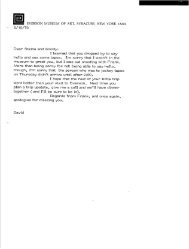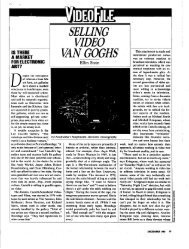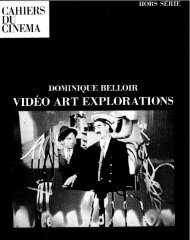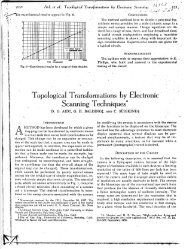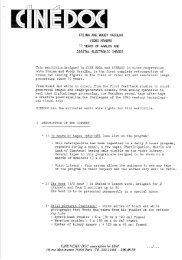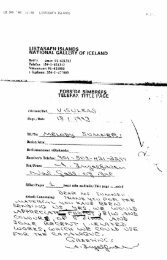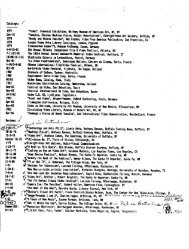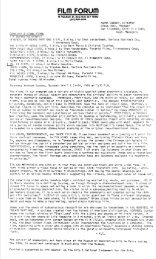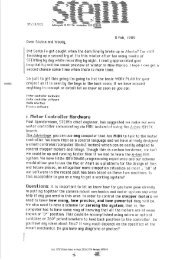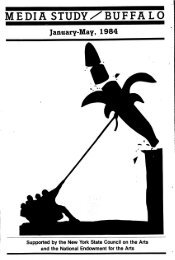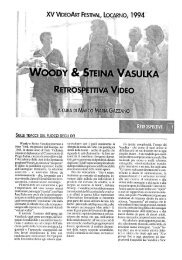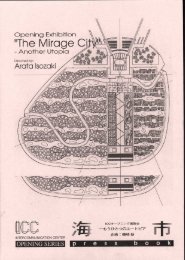Chapter 4: A HISTORY OF COMPUTER ANIMATION ... - Vasulka.org
Chapter 4: A HISTORY OF COMPUTER ANIMATION ... - Vasulka.org
Chapter 4: A HISTORY OF COMPUTER ANIMATION ... - Vasulka.org
Create successful ePaper yourself
Turn your PDF publications into a flip-book with our unique Google optimized e-Paper software.
<strong>Chapter</strong> 4 : A <strong>HISTORY</strong> <strong>OF</strong> <strong>COMPUTER</strong> <strong>ANIMATION</strong> 3/20/92 1 8<br />
engine first (1854), and an American, Herman Hollerith, would most<br />
successfully parley the punch card tabulating machine (fig . 50 .14)<br />
into an industry (1890) . Hollerith got his start tabulating the 1890<br />
census . In 1896 he formed the Tabulating Machine Company to mass<br />
produce his technology ; in 1924 this became a nucleus of the IBM<br />
company . And IBM automated the office, selling a line of products<br />
built around punch cards-keypunches, card punches, printers,<br />
counters, sorters, and eventually, computers .<br />
Mathematical advances were also necessary to advance<br />
computing . Binary numbers, the quantum of data, were introduced<br />
into the West by the Master of Number Bases himself, Napier, in the<br />
1600s . Englishman Ge<strong>org</strong>e Boole found success at developing a<br />
symbolic logic of thought (1854) . In America Charles Pierce applied<br />
boolean logic to electrical switching circuits (1867) and Sheffield<br />
demonstrated that all arithmetical functions could be reduced to the<br />
single logical function notand, the quantum instruction .<br />
If indeed IBM was driving from the side of the punch card then<br />
Western Electric, at its Bell Telephone Laboratories, was driving<br />
from the side of communications . The Bell work was both<br />
theoretical and practical . As early as 1919 telephones began to be<br />
equipped with dialers, so that a switching exchange could<br />
automatically route a call . But it was not untill the 1930s that<br />
Claude Shannon coorelated the overall behavior of electrical<br />
switching circuits to mathematical logic . In 1937 Ge<strong>org</strong>e Stibitz<br />
built an electromechanical relay circuit that performed boolean<br />
logic . Next, he combined these circuits to construct first a binary<br />
adder, and finally an all-binary number calculator capable of<br />
performing all four arithmetic functions . This was demonstrated<br />
over long distance telephone lines (1940) . Before the end of the<br />
1940's, mechanical relays were replaced with vacuum tubes as with<br />
the ENIAC, built by J .P . Eckert and John Mauchly (1945) .<br />
The concept of encoding the instructions as binary codes and<br />
storing them in the computer's memory along with the numerical<br />
data was advanced by Johnny von Neuman (1945) with Alan Turing's<br />
knowledge of what is and is not computable (1936) . The first stored<br />
program computers were built by Maurice Wilkes in Cambridge<br />
(1949), and by Mauchly and Eckert, ultimately at Remington Rand<br />
(1951), who produced what was really the first computer someone<br />
50 .14 . Hollerith tabulating machine counted data recorded on<br />
punch cards . Spring loaded pins push againt the card, and where<br />
there is a hole the pin penetrates the card and completes an<br />
electrical circult .



